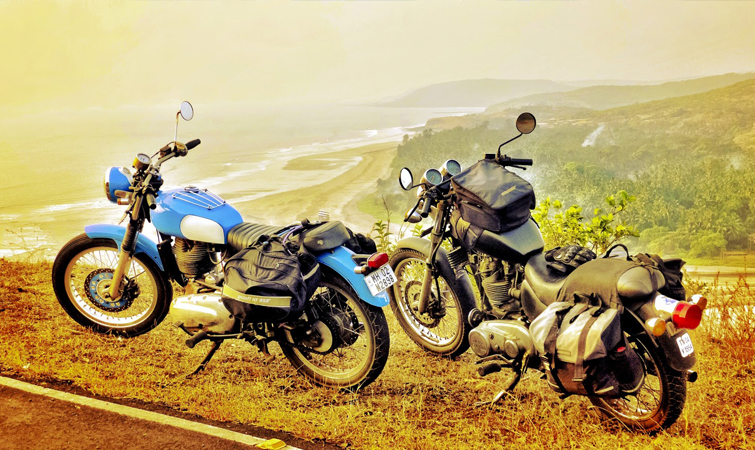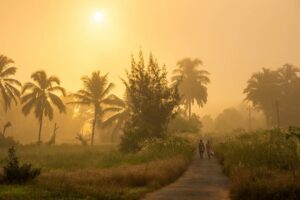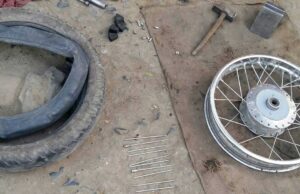You’ve got the inspiration , you have the time and you’ve made up your mind – You are taking that long motorcycle trip in India ! But, don’t know where or what to start planning from ?
Take a word trip with us on a detailed guide of all the tips, tricks, and questions you may have about your motorcycle adventure in India ..

1. Efficient Luggage system, Packing tips, How much to carry ?
Travelling with luggage on a motorcycle can be done efficiently with the right tools.
What are these tools ?
Motorcycle saddlebags
Bungee cords
Magnetic Tank bag
Hard or soft Panniers
Ladakh carrier
Each has its individual benefits and challenges, the right combination of these tools, allowing you to increase the amount of motorcycle touring luggage you can safely carry, while also having easy access to items needed when riding.
Why do these tools makes it easier ?
It evenly distributes the luggage weight around the bike, providing better stability on tricky road conditions, and is definitely more suited for riding long ‘per day’ distances.
How much should I pack for a long motorcycle trip in India?
When packing the ideal rule of thumb is
Three shirts/tees
Three pairs of jeans
Inners, anything you wear on-person on a daily basis.
Alternate these items for : riding, relaxing in the evening, and for any emergencies. This becomes your base. Anything you build over this should be considered as ‘required & quintessential’ or you will end up lugging it around for the trip. Avoid huge bottles of toiletries or makeup (spillage gets messy and fast).
What is the ideal amount of luggage to pack on a long motorcycle trip in India ?
Personally, I prefer to pack enough luggage that will fit in a saddle bag, tank bag and only if needed a 30-50 litre rucksack, plus necessary tools and spares. All this can be removed easily at the end of the day when walking to a hotel or away from your motorcycle for sometime. A Ladakh carrier can carry a lot more and is very helpful when riding with a pillion. Though, treat your bike like a ship, because that’s what it will handle like. 😉

2. Navigating and mitigating risk using GPS, Offline maps and Road maps.
Your best friend on a motorcycle trip is GPS, until it’s not.
The best way to navigate on a motorcycle journey is to have both the old school and new school solutions.
While the ideal option for long distance touring is a dedicated GPS tracker device. Technology today, will allow you to download a paid or free GPS software directly to your phone. The most reliable options are:
Waze
Google Maps
Both apps have their disadvantages and benefits, with Waze being more reliable in real time ‘re-route’ options, as it uses less mobile data.
These days there are a bunch of interesting Apps for motorcyclists worth a look and phone mounts for your motorcycle also present a lot of options.
What is the advantage of having GPS when motorcycle touring ?
Especially, when riding a new route or unfamiliar territory, a GPS system will save you the effort of :
Having to stop every now and then to ask directions or have to leave your bike by itself to ask someone .
Sometimes, no one maybe around or you may be travelling through a protected wildlife sanctuary,deserted route,stranded after dark etc. and unable to ask for directions
The advantage of being able to pre-tag help markers (like police stations & hospitals) for an emergency.
What is the safest solution for motorcycle touring with GPS ?
The best way to navigate on a motorcycle journey is to have both the old school and new school solutions.
Carry an updated road map and pre-save your GPS route with important help locations marked out. This will avoid the mistake of being stranded in an area that has no internet connection or phone connectivity and save you time when in an emergency. There also exists an option to use offline maps as well.

3. Gear essentials, summer motorcycling gear, benefits of a hydration kit, earplugs & a soft piece of cloth..
When touring long distances in South India, summer riding gear is ideal. Here’s a checklist for gear to use :
Motorcycle Jacket with removable breathable liners (protection against rain & cold), removable armor and extra pockets. Check for water resistance capacity.
A sturdy pair of jeans with knee guards for your legs (least safe) or an option of mesh motorcycle armored pants or vented armored riding jeans (both much safer options)
A pair of Sunglasses meant for motorcycling
A pair of mesh riding gloves with knuckle area & palm area protection
Sturdy ankle length boots (preferably vented)
Cooling vest and a moisture wicking tshirt
Ear plugs ( see windblast)
A Hydration pack (see riding dehydration)
A soft piece of cloth to wipe bug splats and micro debris from your helmet visor at intervals
Some tips and tricks to help you ride with gear in all conditions

4. Why do I need travel insurance for a motorcycle trip?
While the concept of Travel Insurance may seem boring.. possibly trivial in light of the adventure you are about to plan, it actually is important. And just like you would choose the right motorcycle gear, you need proper motorcycle travel insurance.
Logically, you would think generic travel insurance is the way to go. But, once you make it known, that you are on a motorcycle trip, a number of general travel insurance companies won’t be of much help.
What to keep in mind when considering motorcycle travel insurance ?
The most important factor to keep in mind is not to be penny wise, pound foolish. Saving a little money by not giving proper details on the type of trip, location of the trip, and class of bike you will be riding, are potential reasons for your insurance claim to be rejected.
When you compare the cost of potential bills without insurance versus the correct motorcycle travel insurance policy that costs a little extra money. Hands down your policy cost will be cheaper and keep you stressfree.
What are the main points to keep in mind when booking motorcycle travel insurance for a long motorcycle trip in India ?
Travel insurance for motorcyclists needs to cover
UNEXPECTED NEED TO CANCEL
TRAVEL PROBLEMS
NATURAL DISASTERS
TERRORISM
LOST OR DELAYED LUGGAGE
ELECTRONIC EQUIPMENT COVER
LOST PASSPORT
SICKNESS OR INJURY
EMERGENCY REPATRIATION
Coming up in Part 2 of planning a long motorcycle trip in india
5 Eating right, sleeping right
6 Preparing for the weather and riding from sunrise to sunset
7 Having safety cash and daily expenses planned
8 Setting the pace for the ride (maintain optimal speed) , and taking regular breaks




